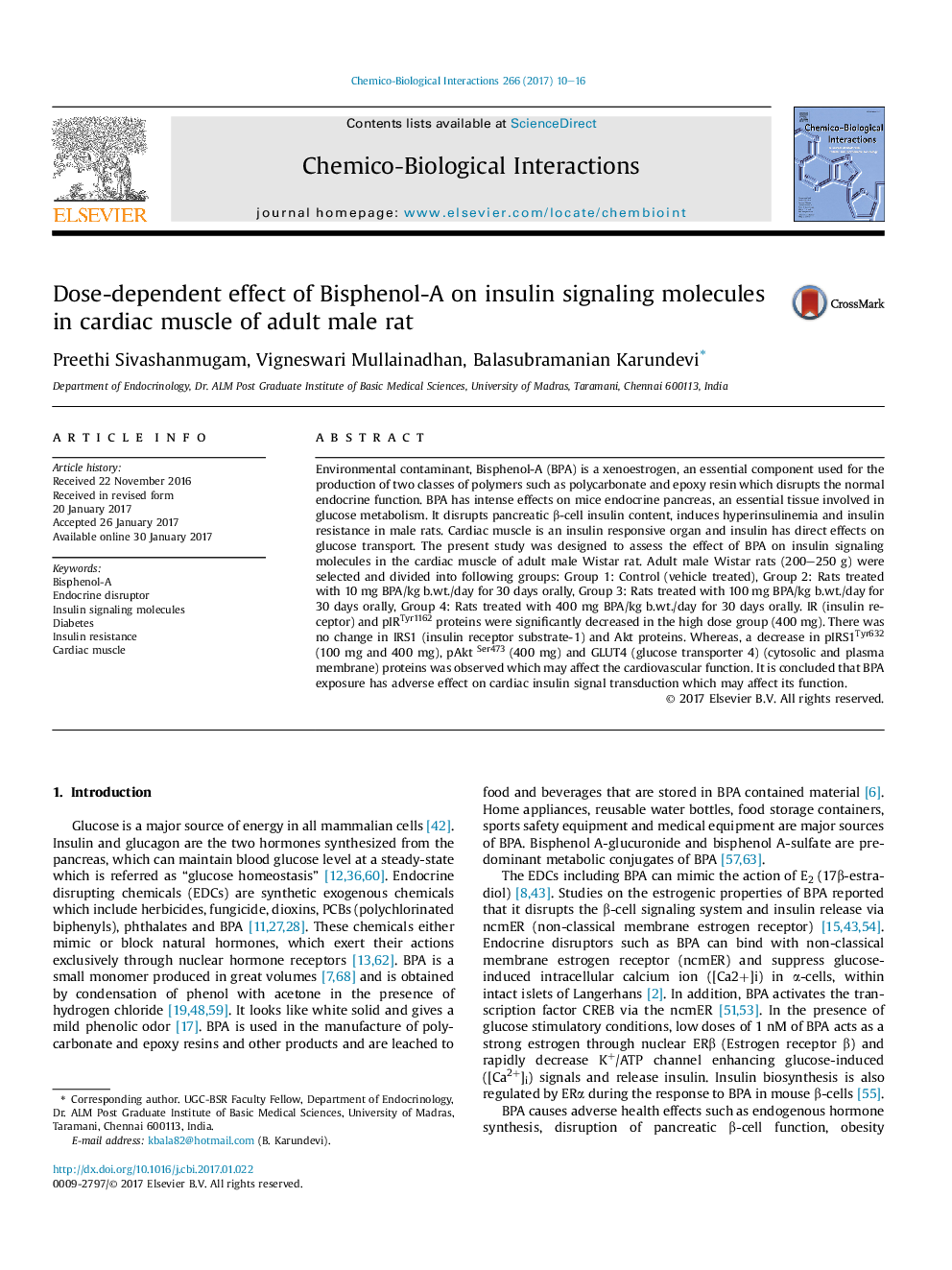| کد مقاله | کد نشریه | سال انتشار | مقاله انگلیسی | نسخه تمام متن |
|---|---|---|---|---|
| 5559414 | 1561576 | 2017 | 7 صفحه PDF | دانلود رایگان |

- Bisphenol-A exposure elevated fasting blood glucose in male Wistar rats.
- Bisphenol-A decreased the weight of male Wistar rats.
- Bisphenol-A has detrimental effects on the glucose metabolism of cardiac muscle.
- Bisphenol-A interfere with insulin signal transduction in cardiac muscle leading to insulin resistance in male Wistar rats.
Environmental contaminant, Bisphenol-A (BPA) is a xenoestrogen, an essential component used for the production of two classes of polymers such as polycarbonate and epoxy resin which disrupts the normal endocrine function. BPA has intense effects on mice endocrine pancreas, an essential tissue involved in glucose metabolism. It disrupts pancreatic β-cell insulin content, induces hyperinsulinemia and insulin resistance in male rats. Cardiac muscle is an insulin responsive organ and insulin has direct effects on glucose transport. The present study was designed to assess the effect of BPA on insulin signaling molecules in the cardiac muscle of adult male Wistar rat. Adult male Wistar rats (200-250 g) were selected and divided into following groups: Group 1: Control (vehicle treated), Group 2: Rats treated with 10 mg BPA/kg b.wt./day for 30 days orally, Group 3: Rats treated with 100 mg BPA/kg b.wt./day for 30 days orally, Group 4: Rats treated with 400 mg BPA/kg b.wt./day for 30 days orally. IR (insulin receptor) and pIRTyr1162 proteins were significantly decreased in the high dose group (400 mg). There was no change in IRS1 (insulin receptor substrate-1) and Akt proteins. Whereas, a decrease in pIRS1Tyr632 (100 mg and 400 mg), pAkt Ser473 (400 mg) and GLUT4 (glucose transporter 4) (cytosolic and plasma membrane) proteins was observed which may affect the cardiovascular function. It is concluded that BPA exposure has adverse effect on cardiac insulin signal transduction which may affect its function.
This figure explains the cascading events involved in insulin signal transduction and the possible mechanism through which Bisphenol-A (BPA) disrupts it leading to insulin resistance. Bisphenol-A (indicated in red arrow), once it enters the cell, it decreases the insulin receptor (IR) protein levels. Similarly, BPA decreases insulin receptor substrate (IRS), the downstream molecule of IR, thereby an alteration in the insulin signal transduction occurs. Akt and its phosphorylated protein decreased which leads to a decrease in the glucose transporter 4 (GLUT4) protein level. The translocation of GLUT4 is affected wherein the availability of GLUT4 on plasma membrane decreases. This leads to a decrease in the entry of glucose via the plasma membrane to cytosol leaving out excess of glucose to stay outside the cell, disrupting the glucose homeostasis causing insulin resistance.292
Journal: Chemico-Biological Interactions - Volume 266, 25 March 2017, Pages 10-16